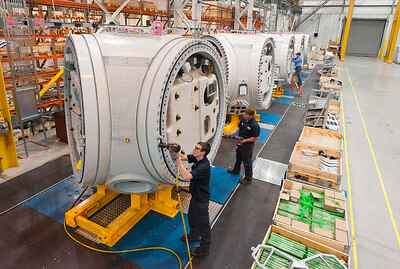5 Green Energy Sources and their Characteristics Explained
Green energy sources are; wind, waves, tides, ocean thermal systems, and sunlight.
It must be noted that green energy sources are not conceptually identical to the sources of clean energy; which are defined solely by their environmental impacts, whereas green energy sources are defined by their availability, natural replenishment, and environmental impacts (a comparison of clean, green and renewable energies can be seen under the explanation of clean energy meaning).
Nuclear radioisotopes represent an example of a clean energy resource, which is not green because they are not naturally replenished. Also, geothermal reservoirs and organic biomass are not always classifiable as green energy resources, because they can release significant amounts of greenhouse gases, and toxins that cause air pollution.
This article discusses green energy sources and their characteristics, as follows;
1). Wind (as one of the Green Energy Sources)
Wind is a green energy source; which usually occurs in the form of mobile air masses.
The classification of wind energy as green, comes from its origin, which includes renewable materials and processes like; Earth's rotation, solar radiation, gravity, air currents and ocean dynamics; and its composition, which does not include any significant amount of toxins or carbon.
Harnessing wind energy is possible using clean technologies like conventional and bladeless wind turbines.
To add to its credit as a source of green energy, wind is fairly abundant in many parts of the world, and can be harnessed in both onshore and offshore terrains.
Electricity generation from wind energy can be used as a means to access electricity in off-grid locations, where wind power from standalone turbines or integrated wind farms, is transmitted to remote buildings using microgrids and other similar systems.
The only possible impacts of wind energy on the ecosystem are those related to the design, transport, installation and decommissioning of wind turbines [3]. Mitigating these impacts has been a focus of sustainable development in the energy sector, and has included efforts to incorporate simpler designs, sustainable materials, and recycling of used turbine components, into the scheme of wind technology.

2). Waves
Waves are a source of green energy that can be used to generate electricity, like all types of renewable energy.
Also, waves share a dynamic relationship with other renewable energy forms like solar and wind, which are involved in the processes that produce and sustain ocean waves [1].
Green energy from waves is simply referred to as wave energy, which occurs in potential, kinetic and mechanical forms.
Waves represent a very promising green energy resource, and are said to have the highest energy density of all known green energy sources.
Harnessing wave energy to generate electricity is done using a relatively-simple system called the wave energy converter, which is equipped with movable parts that are made to oscillate on contact with ocean waves.
Estimates place the potential power-output capacity of waves in the coastal zones of the United States alone, at over 2 trillion kilowatt-hours [2].
3). Tides (as one of the Green Energy Sources)
Tides refer to the continuous rising and falling of water levels in the ocean, as a result of Earth's rotation and internal energy-transfer dynamics between solar, gravitational and aerodynamic entities.
Tidal energy is green because tides contain mainly water and have no toxic elements, waste materials or combustion processes. While it has some effects on aquatic ecosystems and organisms, the harnessing of tidal energy has not been linked to any notable case of marine pollution or atmospheric emission, so far.
Basically, tides are used as an energy source through the installation of turbines underwater, in tidally-active marine zones.
Because water is several times more dense than air, the structural design and material composition of tidal turbines are made to be highly resilient with respect to mechanical stress from moving water masses [5].
As a green energy source, tides have the advantage of being more consistent and predictable that solar radiation, wind or waves.
4). Ocean Thermal Systems
Ocean thermal systems are comprised of seawater masses at various depths in the ocean, and the thermal energy-differences between them [4].
Because ocean thermal energy ultimately comes from the Sun, it can be described as both clean and renewable. The process by which this form of energy is harnessed is referred to as Ocean Thermal Energy Conversion (OTEC).
Types of OTEC systems include open and closed systems, and they operate by thermal energy transfer or heat exchange, which leads to the vaporization of a working fluid, so that vapor produced is used to spin a turbine.
Ocean thermal energy systems are particularly potent in areas where heating of the ocean's surface is intense.
5). Sunlight (as one of the Green Energy Sources)
Sunlight is arguably the most important green energy source available on Earth. It is also the ultimate precursor to all forms of renewable energy.
Energy from sunlight is called solar energy; which is essentially a combination of thermal and light energies that can be transferred by conduction, convection and radiation.
The advantages of sunlight as a source of green energy include its relative abundance, accessibility, multipurpose application, and simplicity of conversion.
Solar energy can be captured and converted using solar panels, collectors, and concentrators. It could be harnessed as heat, light, or an electromagnetic combination of light and thermal radiation.
Green energy from sunlight is indispensable with respect to the goal of energy transition, and the efforts to develop green economies around the world that thrive with low dependence on polluting energy sources, and have a small carbon footprint.
Efforts to improve the way sunlight is harnessed for energy, have also helped in advancing other useful technologies in energy storage, management and transmission.

Conclusion
Green energy sources are;
1. Wind
2. Waves
3. Tides
4. Ocean Thermal Systems
5. Sunlight
References
1). Bennington-Castro, J. (2017). "Why wave power may be the next big thing in green energy." Available at: https://www.nbcnews.com/mach/science/why-wave-power-may-be-next-big-thing-green-energy-ncna823281. (Accessed 25 March 2023).
2). Brigham, K. (2022). "How waves could power a clean energy future." Available at: https://www.cnbc.com/2022/09/07/why-wave-power-could-complement-solar-and-wind.html. (Accessed 25 March 2023).
3). Carrascal, M. H.; Shadman, M.; Amiri, M. M.; Silva, C.; Estefen, S. F.; La Rovere, E. (2021). "Environmental impacts of offshore wind installation, operation and maintenance, and decommissioning activities: A case study of Brazil." Renewable and Sustainable Energy Reviews 144(01). Available at: https://doi.org/10.1016/j.rser.2021.110994. (Accessed 25 March 2023).
4). Cuartas, J. A. H.; Acuña, S. S.; Ibeas, A. (2021). "Ocean Thermal Energy Conversion and Other Uses of Deep Sea Water: A Review." Journal of Marine Science and Engineering 9(4). Available at: https://doi.org/10.3390/jmse9040356. (Accessed 25 March 2023).
5). Finnegan, W.; Allen, R.; Glennon, C.; Maguire, J.; Flanagan, M.; Flanagan, T. (2021). "Manufacture of High-Performance Tidal Turbine Blades Using Advanced Composite Manufacturing Technologies." Appl Compos Mater (Dordr). 2021;28(6):2061-2086. Available at: https://doi.org/10.1007/s10443-021-09967-y. (Accessed 25 March 2023).




